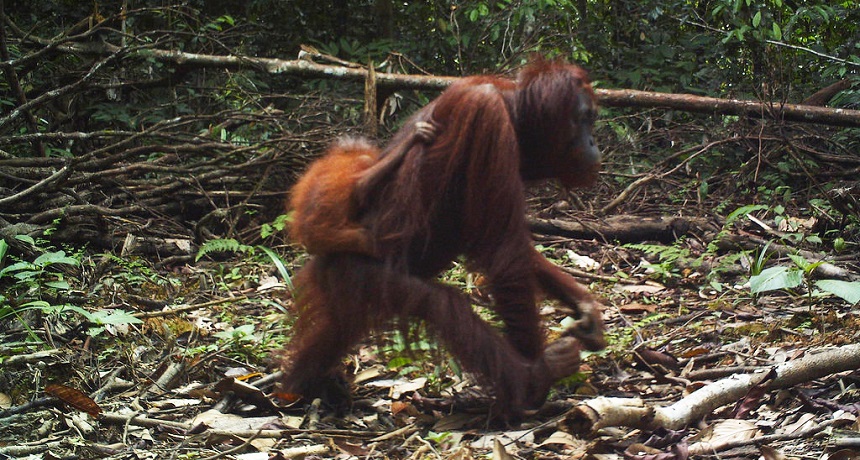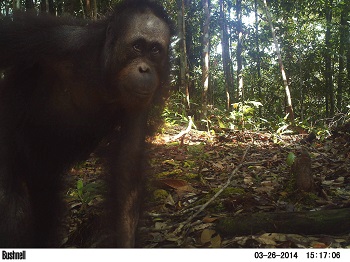Orangutans take the low road
Animals stroll down logging roads when people aren’t watching

A mother orangutan, with a baby on her back, strolls down a path in Borneo.
Brent Loken/Simon Fraser Univ./Flickr (CC-BY 2.0)
By Ilima Loomis
Why did the orangutan cross the road? That’s not the start of a joke, but a question being asked by scientists studying these great apes.
Orangutans are known for traveling through the trees. A new study finds, though, that these red-haired apes walk on the ground more than scientists had realized. These animals also will use logging roads and paths to get around. That means orangutans may be able to adapt to some of the changes that people are making to their forest home.
Brent Loken used camera “traps” to study orangutans. He is a conservation biologist at Simon Fraser University in Vancouver, Canada. He also runs a group called Integrated Conservation. That group protects rare and endangered animals in Borneo, the largest island in Asia. Camera traps work by snapping a photo when something moves in front of them. In Borneo, scientists use the photos to spy on what the endangered orangutans do when people aren’t around.

Orangutan means “person of the forest.” These apes live only in the rainforests of Borneo and the nearby Indonesian island of Sumatra. Scientists have been studying orangutans for decades. And their data had suggested that the animals almost always traveled through the treetops. They were rarely seen strolling across the forest floor. Yet when Loken looked at the photos from his team’s camera traps, he encountered a surprise. The apes were walking on the ground in all parts of the forest. And they did this most often in spots where trees had been cut down. They even used logging roads and paths built by people.
Were these animals simply forced to walk on the ground because logging had left too many gaps in the trees? Or did they amble down logging roads as a convenient shortcut? More research is needed, Loken says, but he thinks they choose the roads because this makes traveling easier.
“They appeared to be walking ‘down the road,’ instead of just crossing it because there was a break in the [forest] canopy,” Loken says. The canopy is the leafy upper portion of a tree or forest.
Another surprise: Orangutans of all sizes, both males and females, walked on the ground and used roads. Scientists used to think only big males risked traveling outside of the trees.
People are removing trees for logging, plantations and development (the building of cities). The new findings suggest orangutans might be able to learn to live with some of these changes to their habitat, Loken says. It doesn’t mean the animals can survive without forests, he cautions. But it does suggest there might be ways to log forests in a way that won’t greatly disturb these apes.
Stephanie Spehar agrees. She’s a primatologist at the University of Wisconsin, Oshkosh, who didn’t work on the study. The new study “doesn’t mean they’re fine in areas with no trees,” she says. Orangutans, she says, “clearly need forest to survive.”
The new study was published online January 22 in the journal Oryx.
Power Words
(for more about Power Words, click here)
adaptation A process by which an organism or species becomes better suited to its environment.
ape A group of rather large “Old World” primates that lack a tail. They include the gorilla, chimpanzees, bonobos, orangutans and gibbons.
Borneo The largest island in Asia and third largest in the world. It is mountainous, covered by vast expanses of rainforest and sparsely populated by people.
canopy (in botany) The top layer of a forest, where the branches of the tallest trees overlap.
conservation biologistA scientist who studies ways to protect the Earth’s biodiversity
development (in economics and the social sciences) The conversion of land from its natural state into another so that it can be used for housing, agriculture, or resource development.
habitat The area or natural environment in which an animal or plant normally lives, such as a desert, coral reef or freshwater lake. A habitat can be home to thousands of different species.
log The process of cutting down trees to get lumber.
plantation A site where some species of tree or other valuable, wild-like plant (such as coffee, banana or tobacco) has been planted as a crop.
primate The order of mammals that includes humans, apes, monkeys and related animals (such as tarsiers, the Daubentonia and other lemurs).
primatologist A scientist who studies primates, a family of animals that includes monkeys, apes and humans.
rainforest Dense forest rich in biodiversity found in tropical areas with consistent heavy rainfall.







